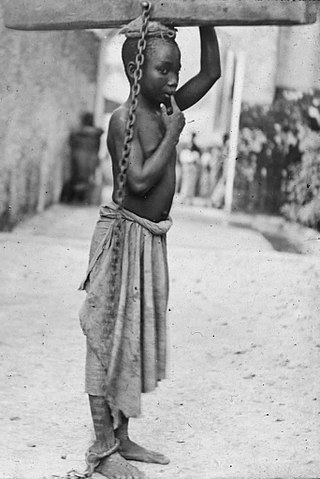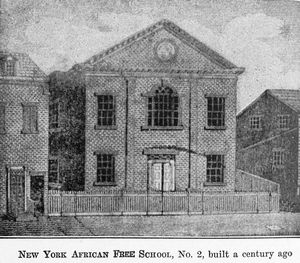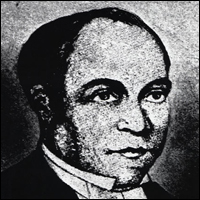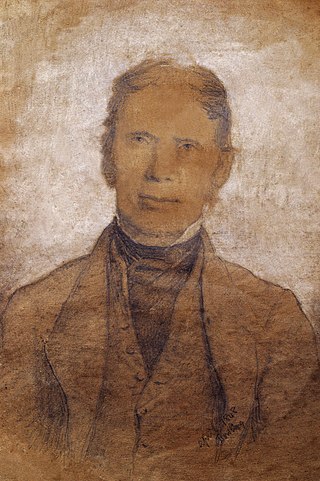
Abolitionism, or the abolitionist movement, is the movement to end slavery. In Western Europe and the Americas, abolitionism was a historic movement that sought to end the Atlantic slave trade and liberate the enslaved people, which eventually spread to eradicate slavery from the entire world.

Henry Highland Garnet was an American abolitionist, minister, educator and orator. Having escaped as a child from slavery in Maryland with his family, he grew up in New York City. He was educated at the African Free School and other institutions, and became an advocate of militant abolitionism. He became a minister and based his drive for abolitionism in religion.

James McCune Smith was an American physician, apothecary, abolitionist and author who was born in Manhattan. He was the first African American to hold a medical degree, awarded by the University of Glasgow in Glasgow, Scotland. After his return to the United States, he became the first African American to run a pharmacy in the nation.

The African Free School was a school for children of slaves and free people of color in New York City. It was founded by members of the New York Manumission Society, including Alexander Hamilton and John Jay, on November 2, 1787. Many of its alumni became leaders in the African-American community in New York.

Peter Williams Jr. (1786–1840) was an African-American Episcopal priest, the second ordained in the United States and the first to serve in New York City. He was an abolitionist who also supported free black emigration to Haiti, the black republic that had achieved independence in 1804 in the Caribbean. In the 1820s and 1830s, he strongly opposed the American Colonization Society's efforts to relocate free blacks to the colony of Liberia in West Africa.

George Donisthorpe Thompson was a British anti-slavery orator and activist who toured giving lectures and worked for legislation while serving as a Member of Parliament. He was arguably one of the most important abolitionists and human rights lecturers in the United Kingdom and the United States.

Elizabeth Nichol was a 19th-century British abolitionist, anti-segregationist, woman suffragist, chartist and anti-vivisectionist. She was active in the Peace Society, the Temperance movement and founded the Darlington Ladies Anti-Slavery Society. In 1853 she married Dr. John Pringle Nichol (1804–1859), Regius Professor of Astronomy at the University of Glasgow. She was one of about six women who were in the painting of the World Anti-Slavery Convention of 1840.

William Smeal (1792–1877) was a grocer and an abolitionist Quaker from Glasgow.
The Emancipator (1833–1850) was an American abolitionist newspaper, at first published in New York City and later in Boston. It was founded as the official newspaper of the American Anti-Slavery Society (AASS). From 1840 to 1850 it was published by the Liberty Party; the publication changed names several times as it merged with other abolitionist newspapers in Boston.

Abolitionism in the United Kingdom was the movement in the late 18th and early 19th centuries to end the practice of slavery, whether formal or informal, in the United Kingdom, the British Empire and the world, including ending the Atlantic slave trade. It was part of a wider abolitionism movement in Western Europe and the Americas.
Events from the year 1833 in Scotland.

Eliza Wigham, born Elizabeth Wigham, was a Scottish campaigner for women's suffrage, anti-slavery, peace and temperance in Edinburgh, Scotland. She was involved in several major campaigns to improve women's rights in 19th-century Britain, and has been noted as one of the leading citizens of Edinburgh. Her stepmother, Jane Smeal, was a leading activist in Glasgow and together they made the Edinburgh Ladies' Emancipation Society. Her brother John Richardson Wigham was a prominent lighthouse engineer.

Jane Wigham was a leading Scottish abolitionist, and was the secretary of the Glasgow Ladies' Emancipation Society.

Priscilla Bright McLaren was a British activist who served and linked the anti-slavery movement with the women's suffrage movement in the nineteenth century. She was a member of the Edinburgh Ladies' Emancipation Society and, after serving on the committee, became the president of the Edinburgh Women's Suffrage Society.

The Edinburgh Ladies' Emancipation Society was a leading abolitionist group based in Edinburgh, Scotland, in the nineteenth century. The women associated with the organisation are considered "heroines" and the impact of these abolitionist organisations for women are thought to have had a notional impact.

Mary Anne Estlin was a British abolitionist and leading figure in anti-slavery and anti-prostitution campaigns in Britain.

The Ladies' London Emancipation Society was an activist abolitionist group founded in 1863, which disseminated anti-slavery material to advance British understanding of the Union cause in the American Civil War as one pertaining to morality rather than territory. This was said to be the first national anti-slavery society for women.

Lucy Townsend was a British abolitionist. She started the first Ladies' Anti-Slavery Society in Birmingham, UK, titled the Birmingham Ladies Society for the Relief of Negro Slaves. Although slavery had been abolished in the UK in 1807, her society was a model for others in Britain and America which campaigned to end slavery in the West Indies and US. The British Ladies' Society's role in abolitionism is considered to have had an international impact.
James Cropper (1773–1840) was an English businessman and philanthropist, known as an abolitionist who made a major contribution to the abolition of slavery throughout the British Empire in 1833.

John Murray (1787–1849) was an abolitionist and social activist who served as Corresponding Secretary of the Glasgow Emancipation Society.
















